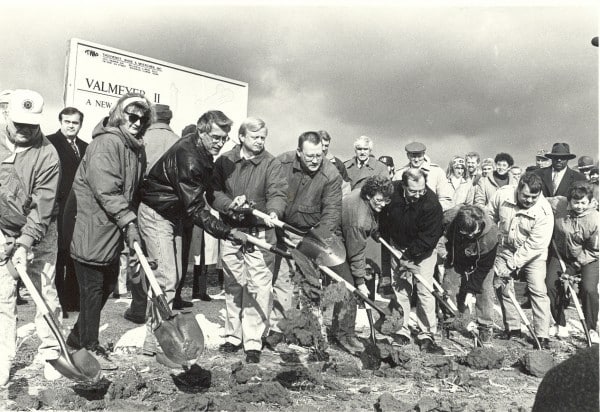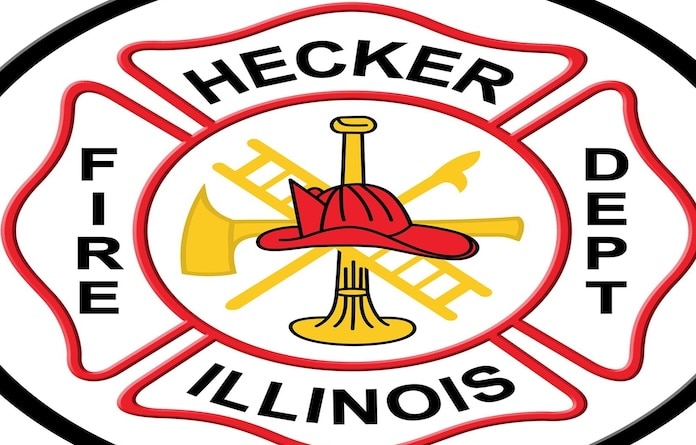After the flood: Valmeyer moves to higher ground

New Valmeyer’s groundbreaking ceremony on Dec. 18, 1993, included local politicians, civic leaders, Illinois Governor Jim Edgar, Congressman Jerry Costello and Senator Paul Simon. (Marvin Cortner photo)
(This is the last article in a three-part series looking back at the Flood of 1993 and its impact on Valmeyer.)
Floods were nothing new to the people of Valmeyer.
But in 1993, when the Mississippi River, which so many times had threatened but never before conquered the resilient community, rose again, there was optimism that once again Valmeyer would prevail. All that changed in the early morning hours of Aug. 1, when Mother Nature had the last word and water finally topped the levee near Columbia and the water rushed toward Valmeyer.
With the water came a difficult question for residents of Valmeyer — rebuild or relocate?
For residents like Susan Schillinger, who didn’t have flood insurance, initial reports that federal money wouldn’t be available to the uninsured set in motion a plan to recover what could be saved and repair the rest. Within days she took out a $40,000 loan and, with the help of family and friends, set about rebuilding her life in the bottoms.
For others, staying was not an option.
“Residents in the bottoms were devastated by the loss of their homes and belongings, and then on top of that, their churches and school suffered the same blow,” said then-mayor Dennis Knobloch.
Even so, when the water first began to recede, residents came back and started cleaning up their property. But a month later, water once again crept into the community, re-submerging many of the homes and businesses.
“It was if someone popped the magic bubble,” Knobloch said. “All hope was lost, and the residents felt totally defeated.”
For Knobloch, whose house had eight feet of water in it, the decision for his family was difficult, but the decision of what to do for his community was not so hard.
“I wanted to do everything in my power to make sure that never happened again, not only for the current residents, but for their children and future generations,” he said. “My feelings were the same (as theirs) – I didn’t want to be concerned about future floods.”
So when residents made the decision to relocate, Knobloch felt a responsibility as their mayor to lead that charge.
“I needed to be a part of that uphill movement as well,” he said.
By early September, Valmeyer and Monroe County officials were beginning to seriously discuss the option of relocating the community to land owned by Walter and Philip Stemler.
“I used to think the time had come when we wouldn’t want to see so much ground under concrete,” Stemler said at the time. “I’ve changed my mind. I think I’d be doing mankind more good by making it available for people to live on than for agriculture.”
Creating a community where there previously were only fields is a daunting task. And the hardest part was simply getting people to agree to it.
“By the second week of September, 40 to 50 families had already moved on,” said Knobloch. “Either they couldn’t wait because the (FEMA) trailers wouldn’t work for their families, or they didn’t think (the) new town would actually happen.”
They lost another family every three or four months, he said.
Another question that had to be answered was about the high school. Initial plans were to only build an elementary school in the new town, with kids going to Waterloo for high school. But for Valmeyer superintendent Harold Baum and the school board, this wasn’t good enough.
“Building a new high school was one of the major components to (the new town) being successful,” Knobloch said.
And keeping the students together until they could move into their new permanent facility was crucial to keeping together the people, if not the town, during the time of transition.
Baum, who would continue as superintendent until 1997, made his mission the rebuilding of the Valmeyer school after the flood, his son Gary said after Harold’s passing last year.
“And he was out there doing the work… digging the holes, pouring the concrete,” Gary Baum said.
Jim Richards, who worked with Baum for 28 years in the school district, agreed.
“If it wasn’t for him, the current school wouldn’t be there,” he said. “He did so much after the flood. Whatever the job, Mr. Baum took care of it.”
By the remarkably early date of Sept. 8, 1993, a temporary school had been set up at the Monroe County Fairgrounds for Valmeyer students. About 450 of the 550-student body had been displaced by the flood, and the temporary facility provided a link among families spread around the county and beyond.
Some students traveled daily from their temporary lodgings as far away as Madison County to stay in the “Valmeyer school.”
Not even three years later, Valmeyer’s elementary and high school would open with 400 students and celebrate its first prom months later.
Another key to keeping the community together in the aftermath of the flood was through their churches. St. Mary Catholic Church and St. John’s United Church of Christ, both of which had been located in Valmeyer since the 1800s, worked to keep their congregations together even as their buildings were uninhabitable.
“Many of these people that were on the planning committee (for the new church), their houses were gone,” current St. John’s UCC consistory president Vince Mehrtens said last year. “They were working to get themselves a new home and a new church.”
The congregation stayed together by holding services at the Monroe County Nursing Home basement in Waterloo. And they were also able to salvage some of the old church building.
“In so many ways, this (new church) reminds us of the old building,” Pastor David Riebeling said last October, when the church celebrated making the final mortgage payment on the current building.
The wood cross that currently hangs above the congregation bears its original watermarks from the flood.
“We thought we’d hang it high enough as so it wouldn’t get wet again,” Riebeling said with a laugh.
At St. Mary’s, Father Ed Hustedde had just moved into the parsonage on July 6, 1993, as the newly assigned pastor. On July 9, he began moving his belongings, still packed in boxes, to higher ground, and he held his first and only Sunday Masses there July 11.
Immediately following the flood, Mass was held at Immaculate Conception Catholic Church in Madonnaville for a time, then at Gibault Catholic High School until a 1995 fire in the library made it unusable and destroyed much of the church’s belongings that had been saved from the flood.
From then on, they held Masses in a temporary trailer used by the Valmeyer school, until the new church opened on Christmas Eve 1995 — complete with the bell from the original building in the old town.
Residence in the new town was made available first to any- one in the floodplain – Valmeyer, Fults and other rural residents displaced by the flood. It opened to the public to purchase lots March 1, 1994.
By 1996, 400 of the old town’s 900 residents had moved into the new town, with another 200 expected to be on their way. The property was annexed into the old with the quarry at Rock City and the Salt Lick area bridging the old and new.
Today, the population stands at 1,200, many of whom relocated from the old town. But some are new to the area entirely.
For the newcomers, the Valmeyer that sits 400 feet atop the bluffs is a small, safe, tight-knit community that is the ideal place to raise a family. To those who moved there from the old town, it is those same things and more.
It represents overcoming tragedy and persevering, making tough decisions and moving forward. But for many, while it is a wonderful place to live, it hasn’t replaced the old town in their hearts — it simply occupies a different place.
“We attended a wedding this past weekend at Borsch Park, and when leaving there, and passing by where our house was, it almost felt like the steering wheel was trying to turn into our former driveway taking us ‘home,’” Knobloch said. “To many of the former Valmeyer residents, even though they are now living in a ‘house’ safely on the hill, the previous location of the town will always be ‘home.’”
Check out parts I & II from the flood series below:
To find out how you can help with the development of a museum in Valmeyer, read the article about a new book and song about Valmeyer by clicking here.






